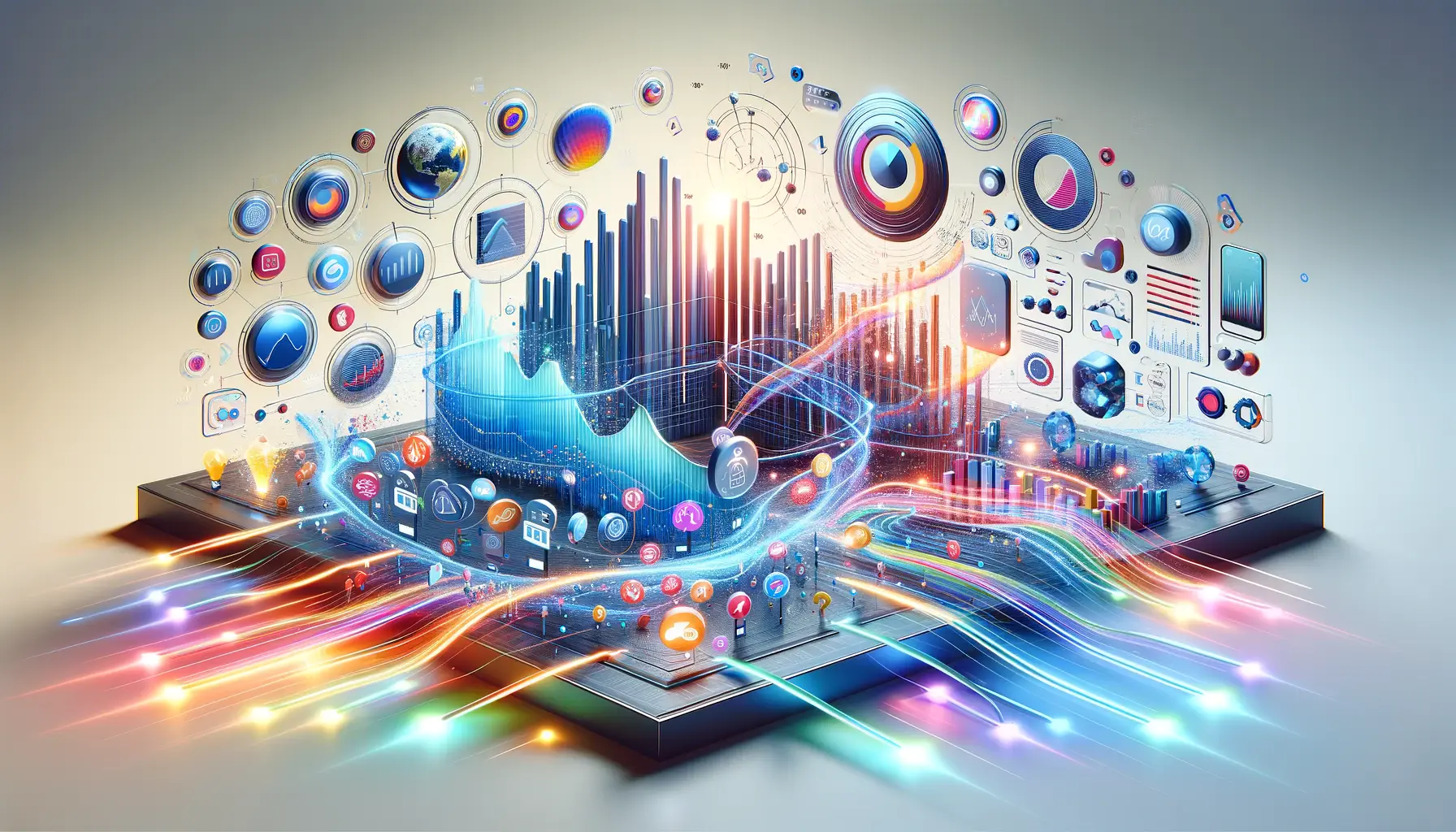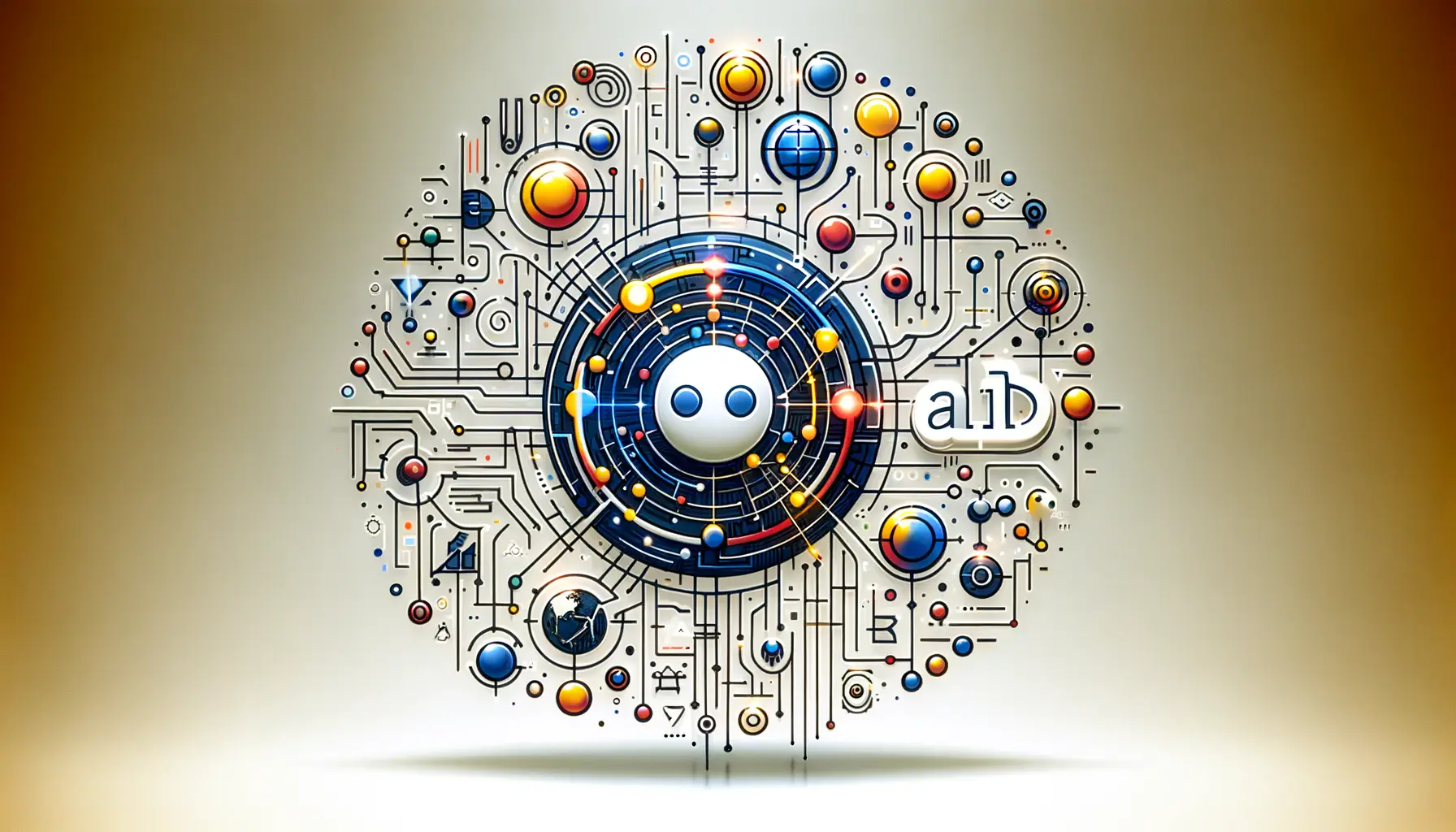The digital advertising landscape is undergoing a significant transformation, thanks in part to the advent of advanced artificial intelligence (AI) tools like Google’s Bard.
As businesses and marketers look to navigate this evolving terrain, understanding the impact of such technologies on advertising strategies becomes paramount.
Google’s Bard, in particular, represents a leap forward in how AI can be leveraged to enhance digital marketing efforts, offering new ways to engage with audiences and analyze data.
The integration of AI into digital advertising is not just a trend but a fundamental shift in how campaigns are designed, executed, and optimized.
With Bard, Google aims to provide marketers with a tool that not only generates content but also offers insights into consumer behavior, market trends, and the effectiveness of advertising strategies.
This article delves into the role of Bard in shaping the future of digital advertising, exploring its capabilities, the trends it’s setting, and how marketers can harness its power to stay ahead in a competitive landscape.
- The Evolution of Digital Advertising with AI
- Enhancing Creative Strategies with Bard
- Impact of Bard on Consumer Engagement
- Optimizing Ad Spend with Bard’s Insights
- Future Trends in Digital Advertising Powered by Bard
- Challenges and Considerations for Marketers Using Bard
- Strategies for Integrating Bard into Marketing Campaigns
- Embracing the Future of Digital Advertising with Google’s Bard
- Frequently Asked Questions About Google’s Bard
The Evolution of Digital Advertising with AI
The introduction of AI technologies like Google’s Bard marks a new era in digital advertising.
Historically, digital marketing strategies heavily relied on human creativity and analysis.
However, the integration of AI tools has revolutionized this approach, enabling more personalized, efficient, and effective campaigns.
Bard, with its advanced language models and data processing capabilities, is at the forefront of this revolution, offering marketers unprecedented insights and automation.
One of the key benefits of Bard is its ability to analyze vast amounts of data to identify trends and patterns that humans might overlook.
This capability allows for more targeted and personalized advertising strategies, which are crucial in today’s saturated digital landscape.
Moreover, Bard’s natural language processing (NLP) technology enables the creation of content that resonates with audiences on a more personal level, enhancing engagement and conversion rates.
Personalization at Scale
Personalization has become a cornerstone of effective digital advertising, and Bard’s AI capabilities are pushing the boundaries of what’s possible in this domain.
By leveraging real-time data and AI-driven insights, Bard enables marketers to create highly personalized ad content that speaks directly to the interests and needs of individual consumers.
This level of personalization not only improves the user experience but also significantly increases the likelihood of conversion.
Furthermore, Bard’s ability to process and analyze data in real-time means that advertising campaigns can be adjusted and optimized on the fly.
This agility is critical in a digital environment where consumer preferences and behaviors can change rapidly.
Marketers can use Bard to quickly identify emerging trends and adjust their strategies accordingly, ensuring that their advertising efforts remain relevant and effective.
AI-driven personalization and real-time data analysis are revolutionizing digital advertising, making technologies like Google’s Bard invaluable tools for marketers aiming to create more engaging and effective campaigns.
Enhancing Creative Strategies with Bard
The advent of AI in digital advertising has not only optimized data analysis and personalization but has also introduced a new dimension to creative strategies.
Google’s Bard, with its sophisticated AI model, is empowering marketers to craft content that is both innovative and resonant with their target audience.
This section explores how Bard is influencing creative processes in digital advertising.
Traditionally, the creation of ad content has been a predominantly human-driven process, relying on intuition, experience, and creativity.
However, Bard’s AI capabilities are enhancing this process by providing data-driven insights that inform and inspire creative decisions.
This synergy between human creativity and AI-driven insights is paving the way for more compelling and effective advertising content.
Content Creation and Optimization
Bard’s impact on content creation is twofold: not only does it assist in generating ideas and writing content, but it also plays a crucial role in content optimization.
By analyzing user engagement and feedback, Bard helps marketers refine their messaging to better align with audience preferences.
This iterative process ensures that ad content remains dynamic and relevant.
- Idea Generation: Bard can suggest content themes and ideas based on trending topics, search queries, and consumer behavior, offering a rich source of inspiration for marketers.
- Writing Assistance: Leveraging NLP, Bard can help craft compelling ad copy, headlines, and descriptions that engage users and encourage action.
- Content Optimization: By analyzing performance data, Bard identifies which elements of an ad campaign are most effective, guiding marketers on how to tweak their content for better results.
Targeting and Segmentation
In addition to enhancing creative strategies, Bard’s AI technology significantly improves targeting and segmentation efforts.
By processing complex datasets, Bard can identify nuanced audience segments and predict their likely response to different advertising messages.
This precision in targeting ensures that ad content is delivered to the most receptive audiences, maximizing impact and ROI.
- Identify audience segments based on demographics, interests, and online behavior.
- Customize ad content for each segment to address specific needs and preferences.
- Continuously refine targeting strategies based on campaign performance and audience feedback.
Incorporating Bard into the creative strategy process enables a more data-driven approach to content creation and optimization, enhancing the effectiveness of digital advertising campaigns.
Impact of Bard on Consumer Engagement
The digital advertising landscape is increasingly competitive, with brands vying for consumer attention in a crowded online space.
Google’s Bard, through its advanced AI capabilities, is redefining how brands engage with their audience, offering new avenues for creating meaningful and lasting connections.
This part of the article examines the impact of Bard on consumer engagement and the strategies it enables for deeper interaction.
Engagement is a critical metric in digital advertising, indicative of how well an audience resonates with the content.
Bard’s AI-driven insights and content generation capabilities are instrumental in crafting messages that not only capture attention but also encourage active participation and interaction from the target audience.
Enhancing User Experience with Personalized Content
At the heart of Bard’s impact on consumer engagement is its ability to personalize content at an unprecedented scale.
Personalized advertising, tailored to the individual preferences and behaviors of users, significantly enhances the user experience, leading to higher engagement rates.
Bard’s AI analyzes user data to deliver content that is relevant, timely, and highly personalized, making each interaction feel unique and valued.
- Utilizing user data to tailor ad messages, ensuring relevance and resonance.
- Creating dynamic content that adapts to user interactions, keeping the experience fresh and engaging.
- Employing predictive analytics to anticipate user needs and present solutions before they are actively sought.
Interactive and Conversational Advertising
Beyond personalization, Bard is paving the way for more interactive and conversational forms of advertising.
By leveraging natural language processing and machine learning, Bard enables the creation of ads that can interact with users in real-time, providing answers, recommendations, and even entertainment.
This interactive approach fosters a two-way conversation between brands and consumers, deepening engagement and building trust.
- Developing chatbot-enabled ads that can answer queries, offer support, and guide users through the buying process.
- Implementing interactive elements in ads, such as quizzes or polls, to encourage user participation and feedback.
- Creating story-driven content that invites users to be part of the narrative, enhancing emotional connection and brand loyalty.
The use of Bard in digital advertising is transforming passive ad experiences into active engagements, leveraging personalized and conversational content to captivate and retain consumer interest.
Optimizing Ad Spend with Bard’s Insights
In the realm of digital advertising, optimizing ad spend is crucial for maximizing return on investment (ROI).
Google’s Bard, with its advanced AI analytics, offers marketers a powerful tool to ensure their advertising budget is allocated efficiently, targeting the right audiences with the right messages at the right time.
This section explores how Bard’s insights can be leveraged to optimize ad spend and enhance campaign performance.
Effective ad spend optimization involves understanding which aspects of a campaign are driving results and which are not.
Bard’s ability to process and analyze large datasets in real time provides marketers with the insights needed to make informed decisions about where to allocate their budget for maximum impact.
Real-time Data Analysis for Agile Decision-Making
Bard’s real-time data analysis capabilities allow marketers to quickly identify trends, measure campaign performance, and adjust strategies on the fly.
This agility is essential in the fast-paced digital advertising environment, where consumer behaviors and market dynamics can change rapidly.
By leveraging Bard, marketers can ensure their ad spend is always directed towards the most effective channels, formats, and messages.
- Monitoring campaign performance across different platforms and devices to identify high-performing areas.
- Adjusting ad spend allocation in response to real-time performance data to capitalize on emerging opportunities.
- Using predictive analytics to forecast future trends and prepare strategies that align with anticipated market shifts.
Enhanced Targeting and Segmentation
Beyond real-time analysis, Bard’s insights contribute to more sophisticated targeting and segmentation strategies.
By understanding the nuances of audience behavior and preferences, marketers can refine their targeting to reach the most receptive segments, thereby reducing waste and enhancing the efficiency of ad spend.
This targeted approach not only improves ROI but also contributes to a better user experience by ensuring that consumers are exposed to ads that are relevant and meaningful to them.
- Utilizing Bard’s data analysis to identify and target high-value audience segments with tailored messaging.
- Refining segmentation strategies over time based on continuous learning from campaign data and consumer feedback.
- Exploring niche markets and untapped audience segments with Bard’s predictive capabilities to discover new growth opportunities.
By harnessing the power of Bard’s AI-driven insights, marketers can optimize ad spend, enhance campaign performance, and achieve a higher ROI, making it an indispensable tool in the digital advertising toolkit.
Future Trends in Digital Advertising Powered by Bard
The integration of AI technologies like Google’s Bard into digital advertising is not just transforming current practices but also shaping future trends.
As we look ahead, the capabilities of AI are expected to drive innovation, leading to new strategies and opportunities for marketers.
This section explores the emerging trends in digital advertising influenced by Bard and how they are likely to impact the industry.
Understanding these trends is crucial for marketers aiming to stay ahead of the curve.
As Bard continues to evolve, its influence on digital advertising strategies, consumer engagement, and ad performance metrics will only grow, setting new standards for what is possible in the digital realm.
AI-Driven Predictive Advertising
One of the most significant trends shaped by Bard is the move towards AI-driven predictive advertising.
This approach leverages AI to analyze data and predict consumer behavior, enabling marketers to create more targeted and timely advertising strategies.
Predictive advertising goes beyond reacting to trends, allowing brands to anticipate needs and interests before they become apparent, offering a proactive way to engage with consumers.
- Utilizing Bard’s predictive analytics to forecast consumer trends and preferences.
- Developing advertising campaigns that preemptively address consumer needs and desires.
- Enhancing ad relevance and timing to improve engagement and conversion rates.
Seamless Omnichannel Experiences
Another trend facilitated by Bard is the creation of seamless omnichannel experiences.
As consumers interact with brands across multiple platforms and devices, providing a cohesive experience becomes paramount.
Bard’s AI can help marketers integrate their advertising efforts across channels, ensuring consistent messaging and branding.
This omnichannel approach not only improves the consumer experience but also boosts brand recognition and loyalty.
- Harmonizing ad content and strategies across digital platforms for a unified brand experience.
- Leveraging Bard’s insights to understand consumer behavior across channels and tailor advertising accordingly.
- Using data-driven insights to optimize the timing and placement of ads, ensuring they reach consumers at the right moment, regardless of the platform.
Enhanced Ad Creativity and Personalization
The capabilities of Bard are also set to push the boundaries of ad creativity and personalization.
As AI becomes more sophisticated, the potential for creating highly personalized and creative ad content that resonates with individual consumers increases.
This level of personalization not only enhances the effectiveness of digital advertising but also contributes to a more engaging and satisfying user experience.
- Employing Bard to generate creative ad content that aligns with individual consumer profiles.
- Using AI to tailor ad narratives and visuals to the preferences and interests of specific audience segments.
- Enhancing the impact of advertising by making every interaction feel unique and personally relevant to the consumer.
The future of digital advertising, powered by AI tools like Google’s Bard, promises more predictive, personalized, and integrated marketing strategies, setting the stage for a new era of consumer engagement and brand communication.
Challenges and Considerations for Marketers Using Bard
While Google’s Bard and similar AI technologies offer transformative potential for digital advertising, their adoption is not without challenges.
Marketers must navigate a range of considerations to effectively leverage these tools, from ethical concerns to technical limitations.
This section outlines the key challenges and considerations for marketers aiming to integrate Bard into their digital advertising strategies.
Understanding these challenges is crucial for harnessing the full potential of Bard while mitigating risks and ensuring responsible use.
As AI continues to evolve, staying informed and adaptable will be key for marketers looking to thrive in the digital advertising landscape.
Ethical and Privacy Concerns
One of the primary challenges associated with the use of AI in advertising is addressing ethical and privacy concerns.
As Bard and similar technologies rely on vast amounts of data to function, ensuring the privacy and security of consumer information is paramount.
Marketers must adhere to data protection regulations and ethical standards, balancing the benefits of AI-driven advertising with the need to protect consumer rights.
- Implementing robust data protection measures to safeguard consumer information.
- Ensuring transparency with consumers about how their data is used and the role of AI in advertising.
- Adhering to ethical guidelines and regulations governing the use of AI and data in advertising.
Overcoming Technical Limitations
Despite its advanced capabilities, Bard, like any technology, has its limitations.
Marketers may encounter challenges related to data accuracy, AI biases, and the complexity of integrating AI tools into existing marketing workflows.
Overcoming these technical limitations requires ongoing learning, adaptation, and collaboration with AI experts to ensure effective implementation.
- Continuously monitoring and refining AI algorithms to address biases and improve accuracy.
- Investing in training for marketing teams to effectively use and understand AI tools like Bard.
- Collaborating with technical experts to integrate AI seamlessly into marketing strategies and platforms.
Keeping Pace with Rapid Technological Change
The pace of technological advancement in AI and digital advertising is rapid, presenting a challenge for marketers to stay current.
As Bard and similar tools evolve, marketers must remain agile, continuously updating their skills and strategies to leverage the latest capabilities.
Staying informed about AI trends and developments is essential for maintaining a competitive edge in digital advertising.
- Engaging in continuous learning and professional development to keep abreast of AI advancements.
- Participating in industry forums, conferences, and workshops focused on AI in advertising.
- Experimenting with new AI features and tools as they become available to discover innovative advertising strategies.
While the integration of AI into digital advertising offers significant opportunities, marketers must navigate ethical, technical, and adaptational challenges to fully realize its potential.
Strategies for Integrating Bard into Marketing Campaigns
As digital advertising continues to evolve, integrating AI tools like Google’s Bard into marketing campaigns offers a pathway to enhanced efficiency, creativity, and engagement.
However, the successful adoption of Bard requires strategic planning and execution.
This section provides actionable strategies for marketers looking to seamlessly incorporate Bard into their digital advertising efforts, ensuring they can leverage its full potential to drive campaign success.
Adopting Bard into marketing strategies not only streamlines operations but also provides a competitive edge in a rapidly changing digital landscape.
By following these strategies, marketers can enhance their advertising campaigns, making them more responsive, personalized, and effective.
Developing a Data-Driven Culture
At the core of Bard’s effectiveness is its ability to analyze and interpret data.
Creating a data-driven culture within your marketing team is essential for leveraging Bard’s capabilities.
Encourage the use of data in decision-making processes, ensuring that campaigns are informed by insights derived from Bard’s analysis.
This approach enhances the relevance and impact of your advertising efforts.
- Invest in training for your team to understand and interpret data analytics.
- Utilize Bard’s insights to inform all stages of campaign planning and execution.
- Encourage experimentation and data-driven hypothesis testing in your marketing strategies.
Personalizing Customer Experiences
Bard’s advanced AI capabilities enable unprecedented levels of personalization in digital advertising.
Use Bard to segment your audience more effectively and tailor your messaging to meet the specific needs and preferences of different customer groups.
Personalized campaigns are more engaging, leading to higher conversion rates and customer loyalty.
- Segment your audience based on detailed data analysis provided by Bard.
- Create personalized ad content that resonates with each segment’s unique characteristics.
- Monitor and adjust your personalization strategies based on campaign performance and feedback.
Leveraging Bard for Creative Content Generation
Bard can be a powerful ally in the creative process, offering new perspectives and ideas that can enhance your advertising content.
Use Bard to generate creative concepts, headlines, and even entire ad copies that are optimized for engagement and conversion.
This not only saves time but also introduces a level of creativity and innovation that can set your campaigns apart.
- Use Bard to brainstorm and refine creative ideas for your campaigns.
- Incorporate Bard-generated content into your ads, testing different approaches to see what resonates best with your audience.
- Continuously refine your creative strategies based on Bard’s ongoing analysis of campaign performance and audience engagement.
Integrating Bard into your marketing campaigns requires a strategic approach focused on data-driven decision-making, personalized customer experiences, and innovative content generation. By embracing these strategies, marketers can harness the power of AI to create more effective and engaging digital advertising campaigns.
Embracing the Future of Digital Advertising with Google’s Bard
The integration of Google’s Bard into the digital advertising ecosystem marks a pivotal shift towards more intelligent, efficient, and personalized marketing strategies.
As we have explored throughout this article, Bard’s capabilities in data analysis, content creation, and consumer engagement are not just enhancing current practices but are also setting the stage for the future of advertising.
The trends driven by Bard and similar AI technologies promise a landscape where predictive advertising, seamless omnichannel experiences, and unprecedented personalization become the norm, rather than the exception.
The Path Forward with Bard
For marketers, the journey with Bard is just beginning.
The potential of this AI tool to transform digital advertising campaigns is immense, offering opportunities to innovate, optimize, and connect with audiences in ways previously unimaginable.
However, realizing this potential requires a commitment to continuous learning, ethical data use, and strategic integration of AI technologies into marketing workflows.
As Bard continues to evolve, so too will the strategies and approaches needed to leverage its full capabilities.
Key Strategies for Success
- Developing a robust understanding of Bard’s technology and its applications in digital advertising.
- Creating a culture of innovation within marketing teams, encouraging experimentation with Bard’s features.
- Ensuring ethical use of data and AI, prioritizing consumer privacy and trust in every campaign.
Looking Ahead
The future of digital advertising with Google’s Bard is bright, filled with possibilities for creating more engaging, effective, and personalized marketing campaigns.
As marketers, embracing these changes and preparing for the future is essential.
By understanding the trends, challenges, and strategies associated with Bard, businesses can not only stay ahead of the curve but also forge deeper connections with their audiences, driving success in the digital age.
Frequently Asked Questions About Google’s Bard
Explore common inquiries surrounding Google’s Bard and its impact on digital advertising.
Google’s Bard is an AI chatbot designed to generate text, answer questions, and assist with a variety of tasks by analyzing web information.
Bard is unique in its ability to access Google’s vast data resources, offering more accurate and comprehensive responses than typical AI chatbots.
Yes, Bard can assist with coding, solve math problems, and support various writing needs, showcasing its versatility across tasks.
Google aspires to create AI that is beneficial, safe, and respects user privacy, focusing on ethical innovation and responsible use of technology.
Bard can analyze trends, generate creative content, and offer personalized advertising solutions, significantly enhancing digital marketing efforts.
While Bard is powerful, it has limitations in understanding context and nuance, requiring human oversight for complex decision-making.
Marketers can use Bard for content creation, data analysis, and to gain insights into consumer behavior, seamlessly integrating it into marketing strategies.
Google plans to continuously improve Bard, focusing on enhancing its understanding, accuracy, and integration with other Google services.












